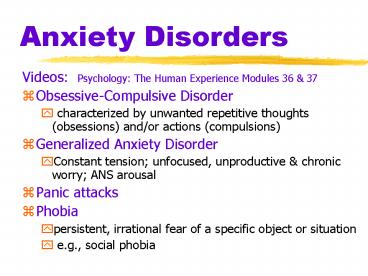Anxiety Disorders - PowerPoint PPT Presentation
1 / 16
Title:
Anxiety Disorders
Description:
Title: Introduction to Psychology Author: Preferred Customer Last modified by: Default User Created Date: 7/7/1998 3:26:24 PM Document presentation format – PowerPoint PPT presentation
Number of Views:55
Avg rating:3.0/5.0
Title: Anxiety Disorders
1
Anxiety Disorders
- Videos Psychology The Human Experience Modules
36 37 - Obsessive-Compulsive Disorder
- characterized by unwanted repetitive thoughts
(obsessions) and/or actions (compulsions) - Generalized Anxiety Disorder
- Constant tension unfocused, unproductive
chronic worry ANS arousal - Panic attacks
- Phobia
- persistent, irrational fear of a specific object
or situation - e.g., social phobia
2
Causes of Anxiety Disorders
- Interaction of factors
- Socio-cultural (culture of fear?)
- Psychological
- Behavioral (CC OC)
- Cognitive (interpretation of harmless situations
as threatening) - Biological
- Heritability twin studies
- GABA
- in OCD, frontal lobe overactivity involved with
directing attention
3
Dissociative Disorders
- Dissociative Identity Disorder (DID)
- Controversy
- Causes?
4
Personality Disorders
- Personality Disorders
- inflexible and enduring behavior patterns that
impair social functioning - e.g., borderline, antisocial (next slide)
5
Antisocial personality disorder
- History of conduct disorder (e.g., habitual
lying, torturing animals) - Problems with impulsivity, failure to plan ahead,
lack of remorse - Seem to be less responsive to fearless (e.g.,
less activity in amygdala and hippocampus to
words that elicit fear compared to non-APD) - In a study of 22,790 prisoners47 of men and 21
of women were diagnosed with APD
5
6
Mood Disorders
Mania
Video Psychology The Human Experience Module 38
Depression
7
Depression subtypes
- Post-partum
- Seasonal affective disorder
8
Rates and Course of Bipolar Disorder
- Lifetime risk of 1.3 for both genders
- 10 have rapid cycling bipolar disorder
- Persistent illness
- 24 relapsed within 6 months
- 77 have at least one new episode within 4 years
- High expressed emotion in the family
(psychosocial stressor)
9
Mood Disorders- Suicide
10
Schizophrenia
- Schizophrenia
- Video Psychology The Human Experience Module
39 - split mind
- severe psychotic disorder characterized by
- disorganized and delusional thinking (e.g., Lena)
- hallucinations (e.g., Terri)
- inappropriate emotions and actions
11
Rates and Course
- About 1 in 100
- Course
- Onset late teens 30s earlier in men than
women (who have a more favorable course) - Prognosis
- Chronic, debilitating disorder for some
- Multiple hospitalizations
- 10-15 will commit suicide
- Many others do not show a progressive
deterioration, but stabilize over the years
12
Causes
- Biological
- Neurobiological Influences
- Increased dopamine activity
- Maternal virus during pregnancy?
- Increased Risk Based on Genetic Relatedness
(next slide)
13
Runs in families
14
Brain Factors
- Several brain regions have abnormalities
- E.g., Ventricle Enlargement
15
Psychosocial and cultural factors
- Social drift
- Stress and relapse
- Communication patterns (high E.E.)
- Cultural acceptance vs. stigmatization
16
Using diagnosis on the job
- Cop Psychiatrists (Sci Amer -- segment 33)































